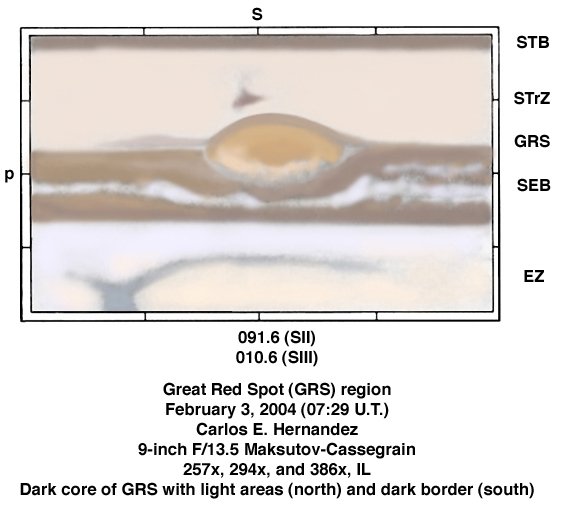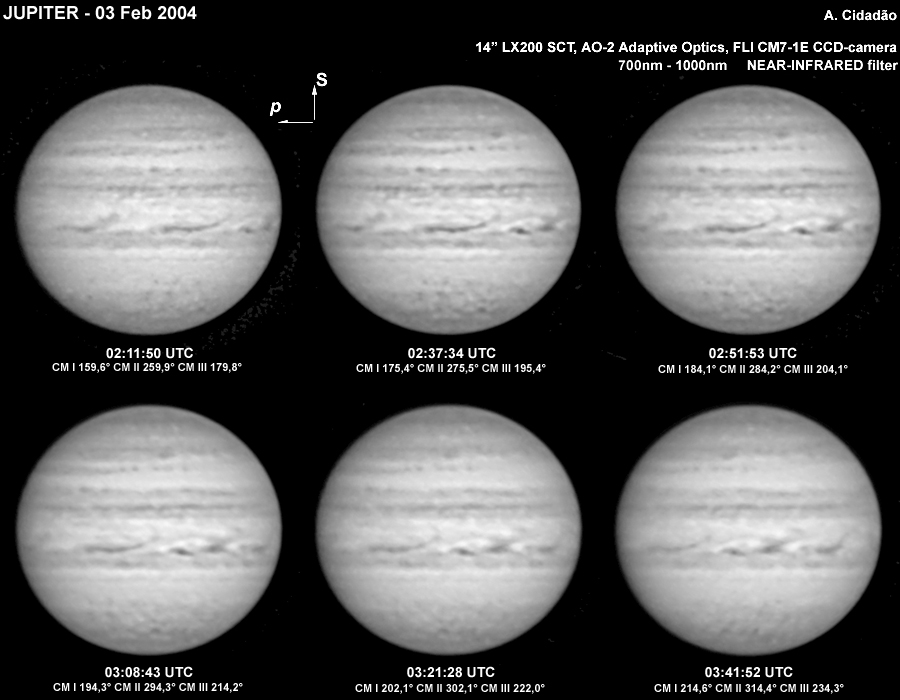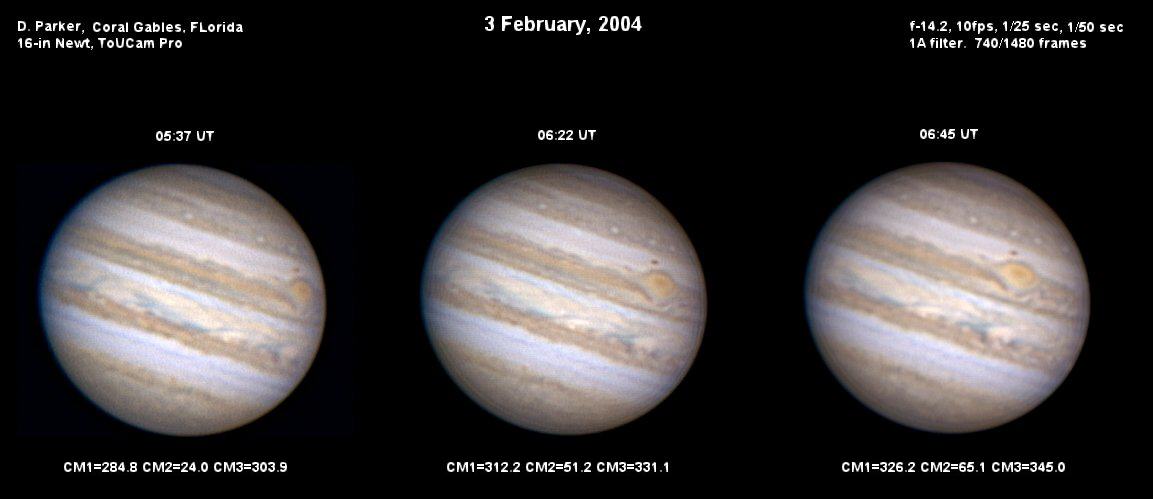|
Carlos E. Hernandez (Drawing:9-inch (23-cm) F/13.5 Maksutov- Cassegrain)
|
I made an observation of Jupiter tonight under good seeing conditions
(6-7/10, moments of 8/10). I was able to make out a significant amount
of detail across the Jovian disk. The Great Red Spot (GRS) was visible
on the following limb when I began my observation, but intermittent
clouds prevented me from making a sketch of this region. The SEB
appeared very complex with a band of condensations ("clumps") noted
over it's following southern border. The Equatorial Zone (EZ) contained
much festoon activity. Many dark barges were noted along the NEB-N. The
following is a description of my observation.
 Date (U.T.): February 27, 2003
Time (U.T.): 02:40
L1 011.0, L2 193.0, L3 021.1
Instrument: 9-inch (23-cm) F/13.5 Maksutov-Cassegrain
Magnification: 282x and 352x
Filters: None
Seeing (1-10): 6-7 (moments of 8/10), Antoniadi (I-V): III-II
Transparency (1-6): 4
Transit Observations:
01:55 U.T., L1 165.7, L3 354.0, WC Bay (Oval) NTrZ (NEB-N border)
02:26 U.T., L2 184.4, L3 012.6, DC Barge NEB-N
02:26 U.T., L1 002.3, L3 012.6, DC Festoon NEB-S
Notes:
South Polar Region (SPR): Appears dusky to dull (4-5/10) with thin
dusky (4/10) bands across the region. The south polar limb appears
dusky (4/10).
South Temperate Zone (STZ): Appears bright (7/10) and thin.
South Temperate Belt (STB): Appears dark (3/10) whereas the preceding
half appears broader than the following half (with two large very
bright (8/10) ovals adjacent to it over the STrZ).
South Tropical Zone (STrZ): Appears bright with two large very bright
(8/10) ovals over it's following half (separated by a thin, dull (5/10)
band).
South Tropical Zone Band (STrZB): The STrZ contains a thin, dull (5/10)
band within it.
South Equatorial Belt (SEB): Appears dark (3/10) and complex. A thin,
bright (7/10) zone appears to bisect the SEB over it's preceding half
then deviating towards the south over it's following half. A section of
dark (3/10) condensations ("clumps") appears along it's following
southern border.
Equatorial Zone (EZ): Appears bright (7/10) containing a dull (5/10)
band (EZB) and blue festoon projections (3-4/10).
North Equatorial Belt (NEB): Appears dark (3/10) and thin with very
dark (2/10) barges along it's northern border (NEB-N) and very dark to
dark (2-3/10) blue festoons along it's southern border (NEB-S).
North Tropical Zone (NTrZ): Appears bright (7/10) with very bright
(8/10) ovals along the NEB-N.
North Temperate Belt (NTB): Appears dull to shaded (5-6/10) and thin.
More prominent over it's following half.
North Temperate Zone (NTZ): Appears shaded to bright (6-7/10), but no
detail noted within.
North Polar Region (NPR): Appears dusky to dull (4-5/10) with dusky
(4/10) condensations and sections noted within.
The best of luck with your own observations and imaging. May you all
have clear and steady skies.
Date (U.T.): February 27, 2003
Time (U.T.): 02:40
L1 011.0, L2 193.0, L3 021.1
Instrument: 9-inch (23-cm) F/13.5 Maksutov-Cassegrain
Magnification: 282x and 352x
Filters: None
Seeing (1-10): 6-7 (moments of 8/10), Antoniadi (I-V): III-II
Transparency (1-6): 4
Transit Observations:
01:55 U.T., L1 165.7, L3 354.0, WC Bay (Oval) NTrZ (NEB-N border)
02:26 U.T., L2 184.4, L3 012.6, DC Barge NEB-N
02:26 U.T., L1 002.3, L3 012.6, DC Festoon NEB-S
Notes:
South Polar Region (SPR): Appears dusky to dull (4-5/10) with thin
dusky (4/10) bands across the region. The south polar limb appears
dusky (4/10).
South Temperate Zone (STZ): Appears bright (7/10) and thin.
South Temperate Belt (STB): Appears dark (3/10) whereas the preceding
half appears broader than the following half (with two large very
bright (8/10) ovals adjacent to it over the STrZ).
South Tropical Zone (STrZ): Appears bright with two large very bright
(8/10) ovals over it's following half (separated by a thin, dull (5/10)
band).
South Tropical Zone Band (STrZB): The STrZ contains a thin, dull (5/10)
band within it.
South Equatorial Belt (SEB): Appears dark (3/10) and complex. A thin,
bright (7/10) zone appears to bisect the SEB over it's preceding half
then deviating towards the south over it's following half. A section of
dark (3/10) condensations ("clumps") appears along it's following
southern border.
Equatorial Zone (EZ): Appears bright (7/10) containing a dull (5/10)
band (EZB) and blue festoon projections (3-4/10).
North Equatorial Belt (NEB): Appears dark (3/10) and thin with very
dark (2/10) barges along it's northern border (NEB-N) and very dark to
dark (2-3/10) blue festoons along it's southern border (NEB-S).
North Tropical Zone (NTrZ): Appears bright (7/10) with very bright
(8/10) ovals along the NEB-N.
North Temperate Belt (NTB): Appears dull to shaded (5-6/10) and thin.
More prominent over it's following half.
North Temperate Zone (NTZ): Appears shaded to bright (6-7/10), but no
detail noted within.
North Polar Region (NPR): Appears dusky to dull (4-5/10) with dusky
(4/10) condensations and sections noted within.
The best of luck with your own observations and imaging. May you all
have clear and steady skies.
 I made a detailed sectional sketch of the region surrounding the Great
Red Spot (GRS) on February 3, 2004 (07:29 U.T.). The core of the GRA
and it's southern border were dark (3/10) whereas the material
surrounding the core was dusky (4/10) with bright (7/10) sections to
the north. A small, dark (3/10) condensation was visible within the
bright (7/10) South Tropical Zone (STrZ) south of the GRS over it's
preceding half. The South Temperate Belt (STB) was visible towards the
south (3/10). The South Equatorial Belt (SEB) exhibited a significant
amount of detail including undulating bright (7/10) rifts, dark (3/10)
condensations, and dusky (4/10) projections (preceding and following
the GRS). The bright 97/10) Equatorial Zone (EZ) included a very dark
(2/10) blue festoon base with a dusky to dull (4-5/10) projection
extending from it over the EZ.
The colors applied were based upon notes made at the telescope and a
color image of Jupiter made by noted imager Donald C. Parker at 06:45
U.T. (44 minutes earlier). I welcome any comments on this sectional
sketch.
The best of luck in your own observations and imaging of Jupiter.
[[Carlos E. Hernandez South Florida U.S.A ]]
I made a detailed sectional sketch of the region surrounding the Great
Red Spot (GRS) on February 3, 2004 (07:29 U.T.). The core of the GRA
and it's southern border were dark (3/10) whereas the material
surrounding the core was dusky (4/10) with bright (7/10) sections to
the north. A small, dark (3/10) condensation was visible within the
bright (7/10) South Tropical Zone (STrZ) south of the GRS over it's
preceding half. The South Temperate Belt (STB) was visible towards the
south (3/10). The South Equatorial Belt (SEB) exhibited a significant
amount of detail including undulating bright (7/10) rifts, dark (3/10)
condensations, and dusky (4/10) projections (preceding and following
the GRS). The bright 97/10) Equatorial Zone (EZ) included a very dark
(2/10) blue festoon base with a dusky to dull (4-5/10) projection
extending from it over the EZ.
The colors applied were based upon notes made at the telescope and a
color image of Jupiter made by noted imager Donald C. Parker at 06:45
U.T. (44 minutes earlier). I welcome any comments on this sectional
sketch.
The best of luck in your own observations and imaging of Jupiter.
[[Carlos E. Hernandez South Florida U.S.A ]]
 ALPO-Japan Latest ALPO-Japan Latest

 Jupiter Section Jupiter Section
|



 [ Joao Antonio Pereira Clerigo: M.Grande, Portugal]
[ Joao Antonio Pereira Clerigo: M.Grande, Portugal] Date (U.T.): February 27, 2003
Time (U.T.): 02:40
L1 011.0, L2 193.0, L3 021.1
Instrument: 9-inch (23-cm) F/13.5 Maksutov-Cassegrain
Magnification: 282x and 352x
Filters: None
Seeing (1-10): 6-7 (moments of 8/10), Antoniadi (I-V): III-II
Transparency (1-6): 4
Transit Observations:
01:55 U.T., L1 165.7, L3 354.0, WC Bay (Oval) NTrZ (NEB-N border)
02:26 U.T., L2 184.4, L3 012.6, DC Barge NEB-N
02:26 U.T., L1 002.3, L3 012.6, DC Festoon NEB-S
Notes:
South Polar Region (SPR): Appears dusky to dull (4-5/10) with thin
dusky (4/10) bands across the region. The south polar limb appears
dusky (4/10).
South Temperate Zone (STZ): Appears bright (7/10) and thin.
South Temperate Belt (STB): Appears dark (3/10) whereas the preceding
half appears broader than the following half (with two large very
bright (8/10) ovals adjacent to it over the STrZ).
South Tropical Zone (STrZ): Appears bright with two large very bright
(8/10) ovals over it's following half (separated by a thin, dull (5/10)
band).
South Tropical Zone Band (STrZB): The STrZ contains a thin, dull (5/10)
band within it.
South Equatorial Belt (SEB): Appears dark (3/10) and complex. A thin,
bright (7/10) zone appears to bisect the SEB over it's preceding half
then deviating towards the south over it's following half. A section of
dark (3/10) condensations ("clumps") appears along it's following
southern border.
Equatorial Zone (EZ): Appears bright (7/10) containing a dull (5/10)
band (EZB) and blue festoon projections (3-4/10).
North Equatorial Belt (NEB): Appears dark (3/10) and thin with very
dark (2/10) barges along it's northern border (NEB-N) and very dark to
dark (2-3/10) blue festoons along it's southern border (NEB-S).
North Tropical Zone (NTrZ): Appears bright (7/10) with very bright
(8/10) ovals along the NEB-N.
North Temperate Belt (NTB): Appears dull to shaded (5-6/10) and thin.
More prominent over it's following half.
North Temperate Zone (NTZ): Appears shaded to bright (6-7/10), but no
detail noted within.
North Polar Region (NPR): Appears dusky to dull (4-5/10) with dusky
(4/10) condensations and sections noted within.
The best of luck with your own observations and imaging. May you all
have clear and steady skies.
Date (U.T.): February 27, 2003
Time (U.T.): 02:40
L1 011.0, L2 193.0, L3 021.1
Instrument: 9-inch (23-cm) F/13.5 Maksutov-Cassegrain
Magnification: 282x and 352x
Filters: None
Seeing (1-10): 6-7 (moments of 8/10), Antoniadi (I-V): III-II
Transparency (1-6): 4
Transit Observations:
01:55 U.T., L1 165.7, L3 354.0, WC Bay (Oval) NTrZ (NEB-N border)
02:26 U.T., L2 184.4, L3 012.6, DC Barge NEB-N
02:26 U.T., L1 002.3, L3 012.6, DC Festoon NEB-S
Notes:
South Polar Region (SPR): Appears dusky to dull (4-5/10) with thin
dusky (4/10) bands across the region. The south polar limb appears
dusky (4/10).
South Temperate Zone (STZ): Appears bright (7/10) and thin.
South Temperate Belt (STB): Appears dark (3/10) whereas the preceding
half appears broader than the following half (with two large very
bright (8/10) ovals adjacent to it over the STrZ).
South Tropical Zone (STrZ): Appears bright with two large very bright
(8/10) ovals over it's following half (separated by a thin, dull (5/10)
band).
South Tropical Zone Band (STrZB): The STrZ contains a thin, dull (5/10)
band within it.
South Equatorial Belt (SEB): Appears dark (3/10) and complex. A thin,
bright (7/10) zone appears to bisect the SEB over it's preceding half
then deviating towards the south over it's following half. A section of
dark (3/10) condensations ("clumps") appears along it's following
southern border.
Equatorial Zone (EZ): Appears bright (7/10) containing a dull (5/10)
band (EZB) and blue festoon projections (3-4/10).
North Equatorial Belt (NEB): Appears dark (3/10) and thin with very
dark (2/10) barges along it's northern border (NEB-N) and very dark to
dark (2-3/10) blue festoons along it's southern border (NEB-S).
North Tropical Zone (NTrZ): Appears bright (7/10) with very bright
(8/10) ovals along the NEB-N.
North Temperate Belt (NTB): Appears dull to shaded (5-6/10) and thin.
More prominent over it's following half.
North Temperate Zone (NTZ): Appears shaded to bright (6-7/10), but no
detail noted within.
North Polar Region (NPR): Appears dusky to dull (4-5/10) with dusky
(4/10) condensations and sections noted within.
The best of luck with your own observations and imaging. May you all
have clear and steady skies.
 I made a detailed sectional sketch of the region surrounding the Great
Red Spot (GRS) on February 3, 2004 (07:29 U.T.). The core of the GRA
and it's southern border were dark (3/10) whereas the material
surrounding the core was dusky (4/10) with bright (7/10) sections to
the north. A small, dark (3/10) condensation was visible within the
bright (7/10) South Tropical Zone (STrZ) south of the GRS over it's
preceding half. The South Temperate Belt (STB) was visible towards the
south (3/10). The South Equatorial Belt (SEB) exhibited a significant
amount of detail including undulating bright (7/10) rifts, dark (3/10)
condensations, and dusky (4/10) projections (preceding and following
the GRS). The bright 97/10) Equatorial Zone (EZ) included a very dark
(2/10) blue festoon base with a dusky to dull (4-5/10) projection
extending from it over the EZ.
The colors applied were based upon notes made at the telescope and a
color image of Jupiter made by noted imager Donald C. Parker at 06:45
U.T. (44 minutes earlier). I welcome any comments on this sectional
sketch.
The best of luck in your own observations and imaging of Jupiter.
[[Carlos E. Hernandez South Florida U.S.A ]]
I made a detailed sectional sketch of the region surrounding the Great
Red Spot (GRS) on February 3, 2004 (07:29 U.T.). The core of the GRA
and it's southern border were dark (3/10) whereas the material
surrounding the core was dusky (4/10) with bright (7/10) sections to
the north. A small, dark (3/10) condensation was visible within the
bright (7/10) South Tropical Zone (STrZ) south of the GRS over it's
preceding half. The South Temperate Belt (STB) was visible towards the
south (3/10). The South Equatorial Belt (SEB) exhibited a significant
amount of detail including undulating bright (7/10) rifts, dark (3/10)
condensations, and dusky (4/10) projections (preceding and following
the GRS). The bright 97/10) Equatorial Zone (EZ) included a very dark
(2/10) blue festoon base with a dusky to dull (4-5/10) projection
extending from it over the EZ.
The colors applied were based upon notes made at the telescope and a
color image of Jupiter made by noted imager Donald C. Parker at 06:45
U.T. (44 minutes earlier). I welcome any comments on this sectional
sketch.
The best of luck in your own observations and imaging of Jupiter.
[[Carlos E. Hernandez South Florida U.S.A ]] ALPO-Japan Latest
ALPO-Japan Latest
